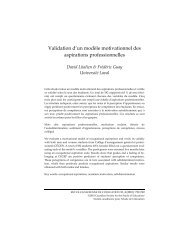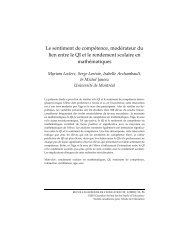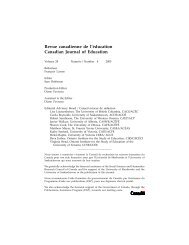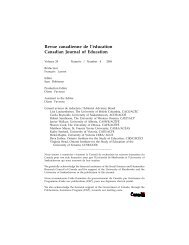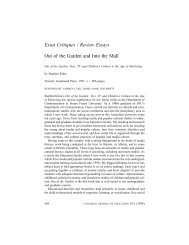Mireille Falardeau et Michel Loranger Le choix de stratégies ... - CSSE
Mireille Falardeau et Michel Loranger Le choix de stratégies ... - CSSE
Mireille Falardeau et Michel Loranger Le choix de stratégies ... - CSSE
You also want an ePaper? Increase the reach of your titles
YUMPU automatically turns print PDFs into web optimized ePapers that Google loves.
464 BOOK REVIEWS / RECENSIONS<br />
the requirements of securing human diversity, compassionate justice, and the<br />
renewal of life” (p. 27). Simon’s “project of possibility” is marked by a profound<br />
sense of the complexities of human lives shaped by larger social configurations.<br />
In the second essay, “The Horizon of Possibility,” Simon constructs the <strong>et</strong>hical<br />
dimensions of this project. He is glaringly aware of the contradictions inevitably<br />
arising from the constrictions within which such a project and its requirements<br />
must be located, where the struggle for transformation is implanted in a restrictive<br />
and divisive social or<strong>de</strong>r. Simon acknowledges the need for a discussion of<br />
these requirements, although his is disappointingly abbreviated. However, his<br />
articulation of the constrictions and requirements of possibility does encourage<br />
the embrace rather than the dismissal of hope in face of the massive educational<br />
venture he envisions.<br />
The scope of the project Simon outlines <strong>de</strong>mands the work of committed<br />
educators across many fronts. The expansion of possibilities for education,<br />
generally, is a hallmark of all of Simon’s work. Y<strong>et</strong>, in “Teachers as Cultural<br />
Workers,” Simon <strong>de</strong>velops the cultural and pedagogical bases for collective<br />
efforts at expansion that are at once enabling and enthralling, nudging as they do<br />
at ways “to constitute, organize and articulate a new s<strong>et</strong> of relations b<strong>et</strong>ween<br />
education and other practices of semiotic production” (p. 39). Naming the work<br />
of education as “semiotic production” (p. 37) and the practices of schooling as<br />
“cultural technologies” (p. 40), Simon locates both within the realm of cultural<br />
studies, a move that “signals a shift from an exclusive concern with the<br />
substance and m<strong>et</strong>hod of representation to questions such as which representations<br />
are engaged by whom, how, why, and with what consequences” (p. 46),<br />
questions that cut to the heart of a project of possibility.<br />
Insisting that “all cultural work needs to address the concerns of pedagogy”<br />
(p. 46), Simon s<strong>et</strong>s the tone for the final essay of section one, “Pedagogy as<br />
Political Practice.” If pedagogy is “an attempt to influence experience and its<br />
resulting forms of subjectivity” (p. 59) through the broad bases of semiotic<br />
productions and cultural technologies, then an attendant <strong>de</strong>mand on pedagogies<br />
is that “the [partial] moral vision they imply must be clarified and subjected to<br />
constant critique” (p. 62). The impositional violence of unreflexive pedagogies,<br />
once named, can be addressed through “a counterdiscursive activity that attempts<br />
to provoke a process through which people might engage in a transformative<br />
critique of their everyday lives” (p. 60), that is, “a pedagogy of possibility” (p.<br />
60). Simon outlines curricular measures to shore up this pedagogy while not<br />
losing sight of the “threat and anxi<strong>et</strong>y in the process” (p. 63). A “sense of<br />
collaborative struggle” (p. 63), “a responsible reflexivity” (p. 64), and “an<br />
assessment of epistemological responsibleness” (p. 65) are dimensions of a<br />
pedagogy of possibility that nurture “communities of solidarity” (p. 65) <strong>de</strong>fined<br />
across difference.<br />
Simon ends this important essay with a especially provocative section in<br />
which, as a response to the work of Jane Gallop, he raises the question “Is there



